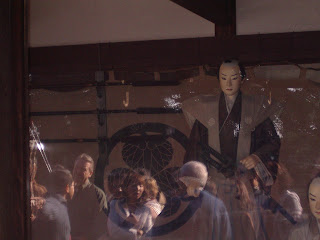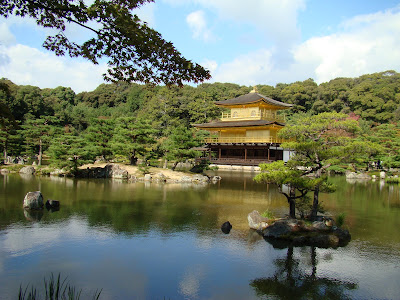Japan Part 5: On Buddha, On Shinto
 Wednesday, November 1, Japan time.
Wednesday, November 1, Japan time.We rise early to another mild morning. The pavement outside is slick with overnight showers, but for the duration of the day a cloudless sky smiles down on us. We make a brief hike to the lobby of one of the more toney local hotels to meet up with our tour group.
Today, we enjoy just being two other gaijin on various whirlwind tours of the local temples and shrines. The buildings we see reveal a scenic and magical window into ancient Japan, and serve as a direct link between the land's past and present.
Our first stop, Nijo Castle, served as sanctuary and political fulcrum for the Edo-era Shogunate. The main focus of our visit, Ninomaru Palace, is built from Hinoki Cypress, and its interiors sport elaborate, gorgeously rendered representations of nature. Beneath the tasteful beauty of the building, however, dwell functions and touches that betray the power and treachery that surrounded this Palace in its halcyon days: Entrances to bodyguards' rooms sit in full view of onlookers, and the wooden floors of the palace's corridors chirp like birds when trod upon (an elaborate--and sonically striking--sixteenth-century alarm system to protect residents and guests).
We also visit Kinkaku-ji, Kyoto's renowned Golden Pavillion. Originally built in 1397
 as a retirement villa for powerful shogun Ashikaga Yoshimitsu and converted into a Zen Buddhist temple by his son, it's surrounded by immaculately-appointed gardens and grounds. Gold leaf encrusts most of the exterior, and the building sparkles in the sunlight. It's so striking that neither its chequered past (it was burned down by a suicidal monk in 1950, then resurrected five years later) nor the tourist throngs clogging its pathways like cholesterol in arteries take away from its glittering beauty.
as a retirement villa for powerful shogun Ashikaga Yoshimitsu and converted into a Zen Buddhist temple by his son, it's surrounded by immaculately-appointed gardens and grounds. Gold leaf encrusts most of the exterior, and the building sparkles in the sunlight. It's so striking that neither its chequered past (it was burned down by a suicidal monk in 1950, then resurrected five years later) nor the tourist throngs clogging its pathways like cholesterol in arteries take away from its glittering beauty.Local shinto shrines provide more tranquil loveliness. All is festive and happy: In addition to tourists we see Japanese
 families coming to pay respects to nature. Thoroughly modern parents dote on their kimono-clad children, and all stop by incense kettles and prayer bells to contemplate and worship. Cherry blossoms envelop the grounds in pink, and vivid orange/red paint covers most of the structures within. You can purchase a paper fortune here, and if it contains ill tidings you can tie the scroll to the branches of a tree, symbolically leaving bad luck behind in favor of a brighter future.
families coming to pay respects to nature. Thoroughly modern parents dote on their kimono-clad children, and all stop by incense kettles and prayer bells to contemplate and worship. Cherry blossoms envelop the grounds in pink, and vivid orange/red paint covers most of the structures within. You can purchase a paper fortune here, and if it contains ill tidings you can tie the scroll to the branches of a tree, symbolically leaving bad luck behind in favor of a brighter future.Strict regulations prohibit photography in Sanjusangendo, an agonizing restriction given the sights beyond this temple's simple wooden exterior. In the temple's main hallway, 1,000 life-sized representations of Kannon (Buddhist goddess of mercy) surround a larger statue of the deity. Kannon the greater possesses 1,000 arms, and each of her finely-detailed
 gold-leaved smaller replicas sports forty arms (one arm, it is said, can save 25 worlds). Carvings of other nature gods populate the front of the hallway, clad in vividly flowing robes and alternately glowering and smiling at dazzled onlookers. The detail, vigor, and unearthly beauty of all of them beggars verbal description.
gold-leaved smaller replicas sports forty arms (one arm, it is said, can save 25 worlds). Carvings of other nature gods populate the front of the hallway, clad in vividly flowing robes and alternately glowering and smiling at dazzled onlookers. The detail, vigor, and unearthly beauty of all of them beggars verbal description. As the sun begins setting we arrive at the site of Kiyomizu Temple. The tour bus stops about a half-mile downhill from the temple, and we hike toward the structure, up paved walkways through a bustling tourist market area. Craft shops, trinket-packed tourist traps, restaurants and shops encrust either side of the pavement; exotic ice creams and distinctively Nihongo snacks beckon; and tourists, locals, and kimono-swaddled young women pack the walkways and stores--a teeming swarm of humanity that provides a cornucopia of people-watching. We're rewarded with a spectacular view of the Kyoto skyline from Kiyomizu's wooden planks. I ponder what this view must've looked like when the temple first saw the light of day in 798 AD.
As the sun begins setting we arrive at the site of Kiyomizu Temple. The tour bus stops about a half-mile downhill from the temple, and we hike toward the structure, up paved walkways through a bustling tourist market area. Craft shops, trinket-packed tourist traps, restaurants and shops encrust either side of the pavement; exotic ice creams and distinctively Nihongo snacks beckon; and tourists, locals, and kimono-swaddled young women pack the walkways and stores--a teeming swarm of humanity that provides a cornucopia of people-watching. We're rewarded with a spectacular view of the Kyoto skyline from Kiyomizu's wooden planks. I ponder what this view must've looked like when the temple first saw the light of day in 798 AD.
Beautiful as it is, Rita and I are forced to make a hasty retreat from Kiyomizu by cab to join our final tour of the night. The driver wends his way around departing tourists and zips down steep narrow alleys like some Far East version of Bullitt, until we're back at our hotel meeting place for the final phase of our whirlwind evening of Kyoto touring.
We hit the Gion District of Kyoto at dusk. It's an area renowned for its proliferation of geisha (more properly known as geiko), its rich artistic heritage, and its tea. Our young guide takes us through a Japanese tea house, outlining the tea ceremony's significance as an oasis of tranquility for everyone from peasants to Shogun. The tour culminates in an authentic tea ceremony in which Rita, three other tourists, and myself enter a small, softly-lit tea room. A petite woman
 in a kimono enters, grinding green tea leaves in a ceramic mortar and pestle with practiced fingers and adding the boiling water with an artisan's attentiveness. We share the thick, rich, heady brew from a common cup (Japanese tradition): It is, indisputably, the most delicious tea I have ever tasted.
in a kimono enters, grinding green tea leaves in a ceramic mortar and pestle with practiced fingers and adding the boiling water with an artisan's attentiveness. We share the thick, rich, heady brew from a common cup (Japanese tradition): It is, indisputably, the most delicious tea I have ever tasted.After the tea, our guide spirits us back to the main dining hall of the tea house/restaurant. The meal bestowed upon us, another vegetarian feast, proves nearly as tasty as Koyasan's dinner fare. The restaurant's host--shorn of head and wisened in appearance, but boyishly enthusiastic--vividly describes the meal, the sequence in which it's to be consumed, and insights on the preparation. His passion for every subtlety and nuance of the food is infectious.
We walk a few blocks through the alleys of Gion, bumping into other tourists and locals. It's nearly 8pm, and the moonlight casts noirish shading on the various restaurants and businesses along the stretch. The doors of many are closed, but there are still families walking about the
 neighborhood. Parents proudly parade their traditionally-clad children, and--good tourists that we are--we readily snap pictures.
neighborhood. Parents proudly parade their traditionally-clad children, and--good tourists that we are--we readily snap pictures.A generous helping of Kyoto traditional musical theater awaits us at our final stop, Gion Corner. This Cliff's Notes review of Kyoto's stage tradition is presented with grace and artisan's care. There's a reenactment of Chado (a traditional Japanese tea ceremony). Then there's Bunraku, a 1200-year-old variety of Puppet Theater which tells the story of a young woman's heartbreak. The elaborate and beautiful puppet, a vision in multicolored robes atop a porcelain face, moves wraithlike thanks to three skilled puppeteers. A dancer in orange robes and a wildly-vivid feline mask performs to Gagaku, (a Japanese variation on Chinese-imported court music). And the broadly-farcical Kyogen variety of comic theater combines rich symbolism with flat-out slapstick silliness: The players execute their shtick (involving a bound man, his arms lashed to a wooden pole, turning the tables on his captors) with the finesse of far east Marx Brothers. All of these venerated performance
 styles reveal much about the audiences for which they were created, whether it's Bunraku's wounded romance, Chado's infusion of tranquil comfort, or Kyogen's apt rib-jabbing at authority.
styles reveal much about the audiences for which they were created, whether it's Bunraku's wounded romance, Chado's infusion of tranquil comfort, or Kyogen's apt rib-jabbing at authority.We cab back to The Oyado Ishicho, utterly exhausted. Tomorrow, Rita and I will go from exploring Japan to turning Japanese. Really.
(all photos, copyright Tony Kay and Rita Bellanca, Taken November 1, 2008)


Comments